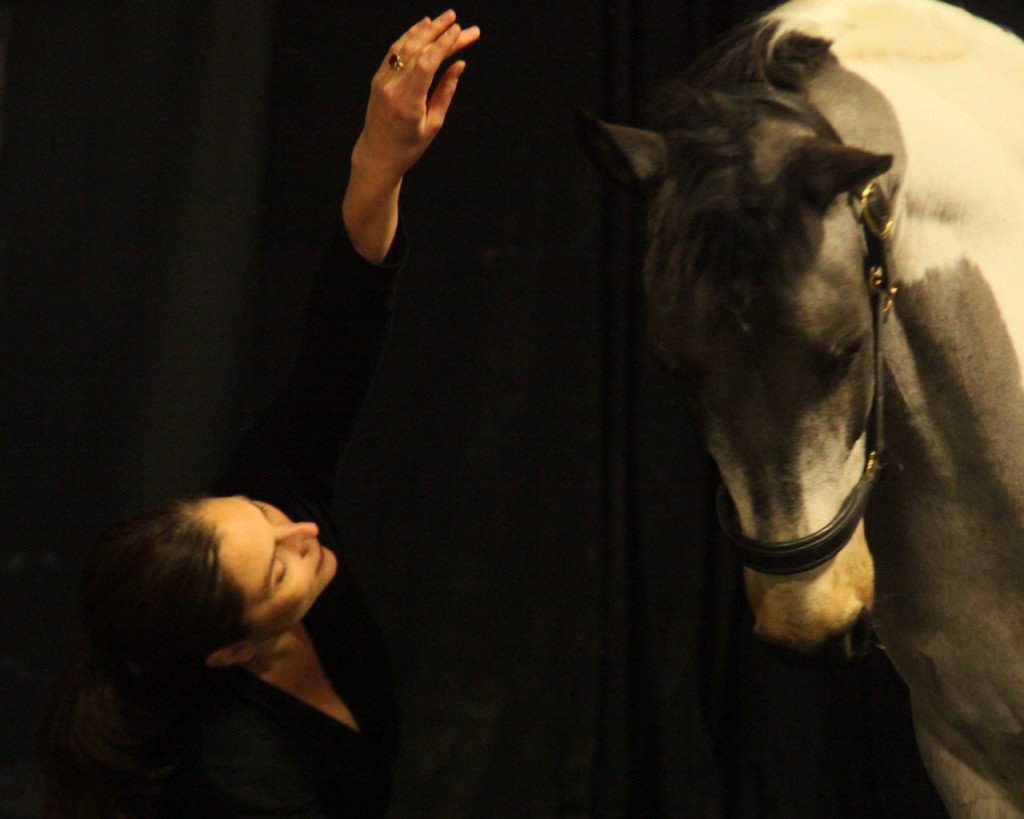 Photo: Jeffrey Anderson; dancer: Ingrid Schatz; Horse: Pony (Escorial)
Photo: Jeffrey Anderson; dancer: Ingrid Schatz; Horse: Pony (Escorial)
In a discussion with some Consciousness Collaborative folks in Boston over the weekend, the question of “What is horsemanship?” came up. Someone had said that they work with horses but do not do horsemanship. I thought that was odd, and wondered out loud how one could spend time with horses and not be doing some kind of horsemanship. I thought about the word dance, and how narrowly defined that can be. The dictionary defines it this way: “move rhythmically to music, typically following a set sequence of steps.move in a quick and lively way.” A fairly 18th century definition and the one that comes up first on a Google search!
This article on the philosophic problems of dance breaks that idea wide open:
Avant-garde experiments use such everyday movements exclusively and without stylization. One choreographer, Anna Sokolow, says she sometimes wonders about “. . . the dividing point between movement and dance. I don’t know and I don’t really care.” Aestheticians and many dance critics, of course, do care about such things. Most would hesitate to call a person walking across a room (even with a radio playing in the background and another person in the room watching) a performance of a dance, although identical movements and accompaniments might be found in a performance.
The use of random movements is another rejection of formalized dance movement. Merce Cunningham, who has collaborated extensively with avant-garde composer John Cage, uses random selection methods for the choice of steps and step-sequences in his dance performances. Randomness and everyday movements again suggest that dance is in part a function of something other than the characteristics of the movement per se, such as the relationship between spectator and performer and the standards for appreciating and evaluating the movements. The room-walking would be art if the walker did it for the purpose of being observed, appreciated, and evaluated as a performance by the other person, and if the observer also appreciated the movement as a performance, despite the absence of a traditional theater. Standards for appreciation and evaluation as dance might involve unity, meaningfulness, and so forth, rather than non-art standards of, say, how efficiently the walker crossed the room to answer the doorbell or how carefully he walked to avoid toys on the floor.
Traditional assumptions about the role of music are also being challenged. Historically, views on the role of music have shifted from (1) the belief that music should provide only the “beat,” but otherwise not “interfere” with the dancing; to (2) the nineteenth-century view that music should complement, but not overwhelm, the mood of the dance; to (3) the twentieth-century view that music and dance should be integrally related, with the dance providing a visualization and expansion of the complex relationships in the music. Avant-garde choreographers challenge all of these views.
My own very spacious definition of dance is basically “any movement in time and space with intention in the presence of a witness.” Intention is the trick word here – what is the mover/movement-maker intending? The witness could be an audience of one or thousands. On the other hand, when I am rehearsing alone is it dancing? Yes. I find it easy to feel when my movement has morphed into some kind of dancing. On the other hand, the minute I enter the stable, I am practicing some kind of horsemanship. The thing that makes it horsemanship is the quality of consciousness in the relationship.
Horsemanship is, according to one definition, is “the art, ability, skill, or manner of a horse(wo)man.” I actually like that and find it commodious. To me, that includes all the practices of equine assisted this or that, riding, and spending any kind of intentional time with horses, regardless of the specific intention, place, time, horse or practice. Is there good horsemanship and bad horsemanship? You bet. Is it easier to determine than bad or good dance? You bet. An offended or bored audience can pretty much up and leave at any time. The horse is not so lucky. They have to stay around for the whole performance. If they do up and leave, it does not end well for the horse.
Yesterday, I spent a lovely morning with my friend Elvia, doing Embodied Horsemanship. What were we doing? We started with some horseless work – somatic movement awareness practices, some improvisational games, some of the softness and balance exercises from Mark Rashid, some conversation about intention, balance and listening. Then we went over to the Equus Effect and played with the lovely Tango. We focused on attunment, listening, on integrating some of the improvisation strategies and somatic exercises into the simple groundwork with Tango. We played in the Tellington-inspired labyrinth. Horsemanship? Yes.
My friend Ann Carlson has one of the stretchier approaches to dance of anyone I know. For your dance and cowmanship pleasure. (In case you cannot see, the anonymous-making hooded raincoats are filled with cash – a comment on the monetization and facelessness of our food animals).